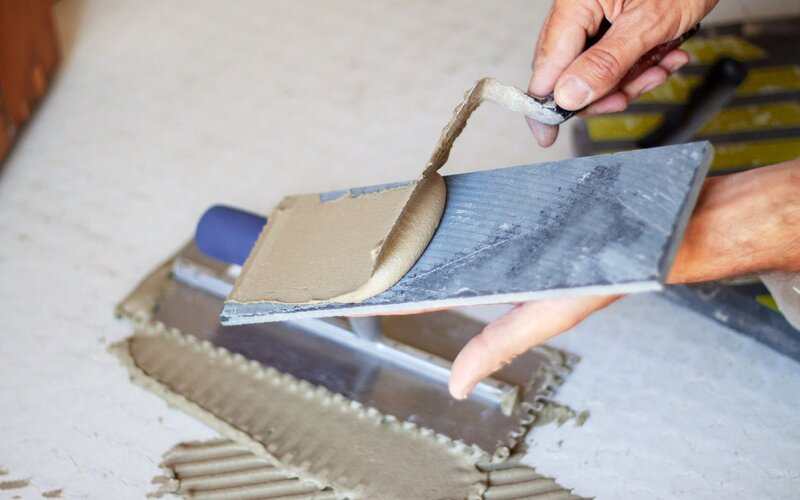Installing tiles requires tile adhesive, often known as mortar or tile glue. Whether undertaking a do-it-yourself home improvement project or managing a professional construction project, knowing the ins and outs of it is essential for assuring a successful and durable tile installation. This comprehensive tutorial delves into it, covering its types, application methods, suggestions for picking the best glue, and best practices for flawless installation.
What is adhesive for tiles?
It is a specially formulated, polymer-modified, flexible adhesive that can be used to fix a variety of tile types, including mosaic tiles, ceramic tiles, clay & ceramic (non-vitrified) tiles of small and ample proportions, engineered tiles, and all-natural stone tiles, among others.
It is a commercially accessible mixture of Portland cement, polymers, and specific aggregate pieces with added additives, improving the quality of bonding the tiles to the surface. Specialized compounds with excellent adhesive properties, little shrinkage, and increased strength are present. It may be used in wet and dry environments and is quite flexible to accommodate thermal and physical motions.
Cement and Tile Adhesive: Their Differences
Traditionally, cement mortar and cement slurry were employed to connect tiles. Because cement dries quickly, applying it would leave empty gaps underneath the tile’s surface, eventually causing cracked and chipped tiles in a noticeably short time. Before the use of cement, the supply of natural sand helped them.
Less material is needed when using it to lay tiles with a notched trowel. Because the adhesive is thinner than the sand-cement mixture, it reduces the load on the structure.
The primary purpose of tile adhesive is to quickly and easily bond tiles to surfaces. Its workability is enhanced by using polymers and graded aggregates, which also add superior adhesive and water-proofing qualities. Concerning bonding strength, cement mortar mix is inferior to tile adhesive, offering less durability.
Various Tile Adhesives Because the adhesive is thinner than the sand-cement mixture, it reduces the load on the structure.
ü Concrete-Based: Cement, sand, and additives are the main ingredients of this conventional adhesive. It can be used for various tile types, including ceramic, porcelain, and natural stone, and is appropriate for indoor and outdoor installations. Strong bonding capabilities are provided by cement-based adhesive, which comes in a variety of formulas for various tile applications.
ü Acrylic Base: An acrylic adhesive is a flexible choice that is pre-mixed and ready to use. It is appropriate for non-porous, lightweight tiles like glass and mosaic tiles. Acrylic adhesive is a common option for DIY enthusiasts because of its flexibility, water resistance, and simplicity of application.
ü Epoxy: The strength and durability of epoxy adhesive are unmatched. It is perfect for demanding tasks, humid locations, and places exposed to harsh chemicals or temperatures. Epoxy adhesive offers a solid bond for difficult installations and is frequently utilized in commercial and industrial environments.
The Best Adhesive Buying Guide
- Examine the area and type of tile: Specific adhesives are required for various types of tiles. While non-porous tiles, like porcelain, can be fitted with a regular adhesive, porous tiles, like natural stone, may require a specialized adhesive to prevent discoloration.
- Examine environmental aspects: Adhesives with the necessary characteristics are needed for environments with high moisture content, temperature changes, and chemical exposure. Ensure the adhesive you select can survive the installation area’s environmental conditions.
- Consult the manufacturer’s suggestions: The producers of the tiles frequently recommend the best sort of glue to use with particular types of tiles. Compatibility and top performance are guaranteed by heeding these suggestions.
Recommended Techniques for Applying
- Surface Cleaning: For a tile installation to be successful, the surface must be clean, dry, and well-prepared. Before using the fresh glue, clear the area of any trash, dust, or old adhesive.
- Observe the mixing directions: Be sure to carefully follow the manufacturer’s instructions for any adhesive kinds that call for mixing. The consistency and efficiency of the adhesive are guaranteed by proper mixing.
- Apply uniformly: Apply the glue uniformly, whether with a trowel or a spreader, to lay a sturdy foundation for the tiles. Poor bonding and uneven tiles might result from uneven glue application.
- Smaller Sections of Work: Apply adhesive to a manageable space that can be tiled in the suggested amount of time. This ensures the adhesive won’t dry out before the tiles are set.
Other Actions Needed:
- Surface preparation: Use sandpaper, a wire brush, or water jetting to remove any loosely adhering materials, dust, or debris from the surface before applying it. A substratum made of cement must be at least 28 days old. More than 5 mm of thickness may be necessary for uneven surfaces.
Mixing properly involves progressively combining the tile glue with clean water to create an adhesive. Use a heavy-duty paddle mixer to continue mixing for 3 to 5 minutes to create a homogenous paste with a creamy, lump-free consistency. Make sure the mixture is homogeneous and free of lumps or dry powder. This will facilitate simpler applications and increase coverage. Within the pot’s lifespan, it is used.
ü Product quality and notched towel: Look for a product of reasonable quality that includes features like advice on the applicability of use, internal testing facility, etc. A notched trowel must be used when applying tile glue to the surface.
It comes in a wide range of brands currently on the market. It is crucial to consider its region of use while choosing the best one. However, even if you choose the perfect product, the intended results won’t be obtained until the surface preparation, mixing, bedding, notching, installing tiles, and grouting are done properly.
Conclusion
The completed project’s stability, toughness, and beauty are all impacted by tile adhesive, which is a crucial component of the tile installation process. You may ensure a successful and durable tile installation by comprehending the many types of adhesive, suitable application techniques, and factors impacting adhesive choice. The information you’ve learned from this article will put you on the right track to obtaining spectacular, dependable results, regardless of whether you’re starting a DIY project or supervising a professional installation.





